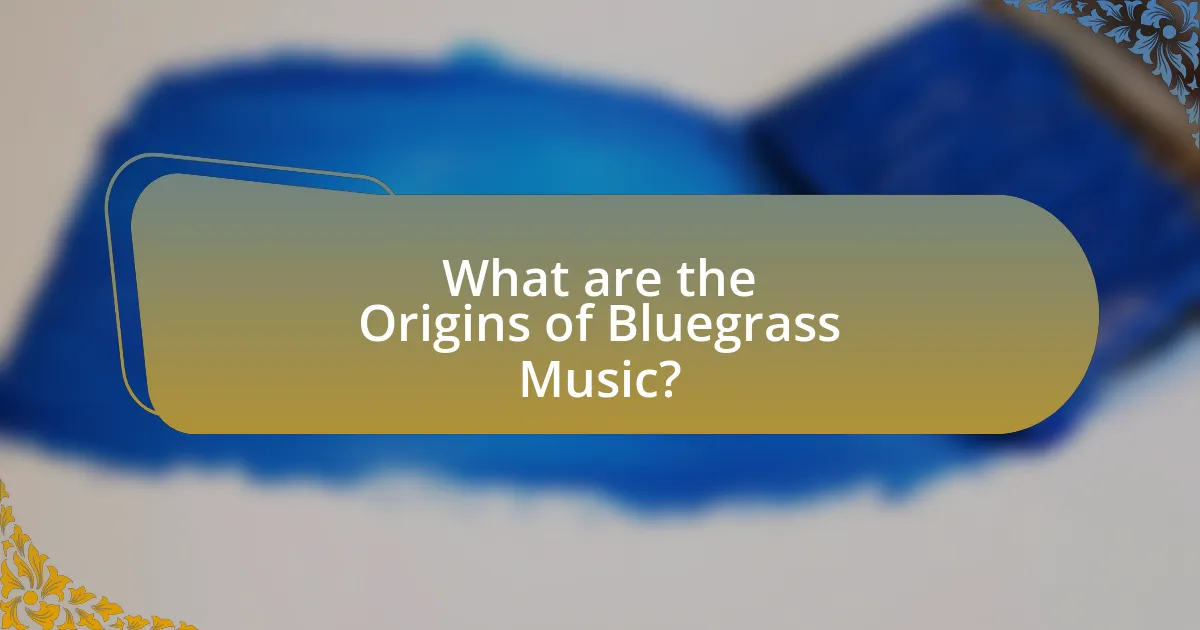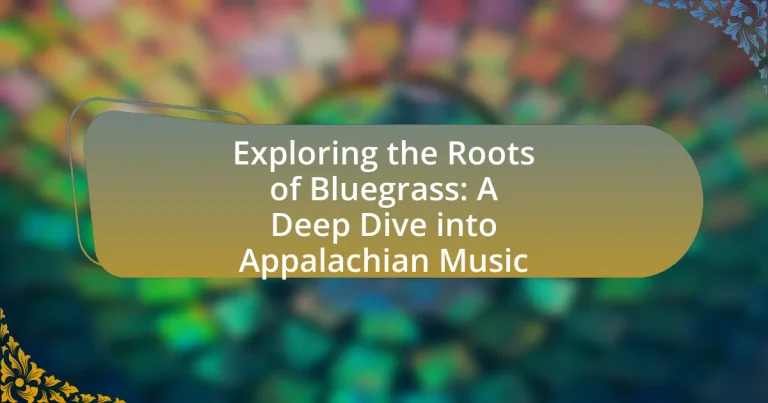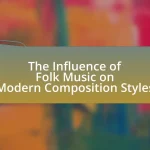The article explores the origins and evolution of Bluegrass music, a genre that emerged in the 1940s in the United States, primarily influenced by Bill Monroe and his band, the Blue Grass Boys. It delves into the cultural significance of Appalachian music, highlighting the traditional instruments, folk traditions, and storytelling that shaped Bluegrass. Key figures such as Monroe, Earl Scruggs, and Lester Flatt are discussed for their contributions to the genre, alongside the impact of technology and modern trends that have redefined Bluegrass. The article also examines common themes in Bluegrass lyrics, including social issues and personal experiences, while emphasizing the genre’s ongoing relevance and appeal to diverse audiences today.

What are the Origins of Bluegrass Music?
Bluegrass music originated in the 1940s in the United States, primarily attributed to the influence of Bill Monroe and his band, the Blue Grass Boys. This genre emerged from a blend of traditional Appalachian folk music, blues, and jazz, reflecting the cultural melting pot of the Appalachian region. The term “bluegrass” itself derives from the name of Monroe’s band, which was named after Kentucky’s Blue Grass region, known for its rich musical heritage. The instrumentation typically includes the banjo, mandolin, fiddle, guitar, and upright bass, which are characteristic of the style. The genre’s roots can be traced back to earlier forms of American folk music, particularly the Scots-Irish musical traditions brought by immigrants to the Appalachian Mountains.
How did Appalachian culture influence the development of Bluegrass?
Appalachian culture significantly influenced the development of Bluegrass music through its unique blend of folk traditions, instruments, and storytelling. The region’s rich musical heritage, characterized by the use of instruments like the banjo, fiddle, and mandolin, laid the groundwork for Bluegrass. Additionally, the storytelling aspect of Appalachian culture, often reflecting themes of hardship and community, became integral to the lyrical content of Bluegrass songs. This cultural backdrop is evidenced by the music of pioneers such as Bill Monroe, who incorporated traditional Appalachian sounds and narratives into his work, solidifying Bluegrass as a distinct genre rooted in the experiences and traditions of the Appalachian people.
What traditional instruments are integral to Bluegrass music?
The traditional instruments integral to Bluegrass music include the banjo, mandolin, fiddle, guitar, and upright bass. These instruments form the core sound of Bluegrass, which originated in the Appalachian region of the United States in the 1940s. The banjo, often characterized by its distinctive twang, is a key element in driving the rhythm, while the mandolin adds melodic texture. The fiddle contributes to the genre’s rich harmonies, and the guitar provides both rhythm and lead lines. The upright bass anchors the ensemble with its deep, resonant tones, completing the traditional Bluegrass instrumentation.
How did folk traditions shape the sound of Bluegrass?
Folk traditions significantly shaped the sound of Bluegrass by integrating elements from various musical styles, particularly Appalachian folk music, African American blues, and traditional Irish and Scottish melodies. The instrumentation commonly associated with Bluegrass, such as the banjo, mandolin, and fiddle, reflects these folk roots, as these instruments were prevalent in the rural communities of the Appalachian region. Additionally, the vocal harmonies and storytelling aspects of Bluegrass music draw directly from folk traditions, emphasizing themes of everyday life, love, and hardship, which resonate with the cultural experiences of the communities from which Bluegrass emerged. The genre’s development in the mid-20th century, particularly through artists like Bill Monroe, further solidified these folk influences, creating a distinct sound that remains rooted in its traditional origins.
What role did early pioneers play in Bluegrass music?
Early pioneers played a crucial role in the development of Bluegrass music by blending traditional Appalachian folk music with elements of jazz and blues. Key figures such as Bill Monroe, often referred to as the “Father of Bluegrass,” established the genre’s distinctive sound in the 1940s through his innovative use of instrumentation, including the mandolin, banjo, and fiddle. Monroe’s band, the Blue Grass Boys, showcased this new style, which emphasized high harmonies and fast tempos, influencing countless musicians and solidifying Bluegrass as a unique genre. Additionally, pioneers like Earl Scruggs revolutionized banjo playing with his three-finger picking style, further defining the sound of Bluegrass music.
Who were the key figures in the formation of Bluegrass?
The key figures in the formation of Bluegrass include Bill Monroe, Earl Scruggs, and Lester Flatt. Bill Monroe, often referred to as the “Father of Bluegrass,” established the genre in the 1940s with his band, the Blue Grass Boys, blending traditional Appalachian music with jazz and blues elements. Earl Scruggs revolutionized the banjo playing style with his three-finger picking technique, which became a defining characteristic of Bluegrass music. Lester Flatt, as the lead vocalist and guitarist of the Foggy Mountain Boys, contributed significantly to the genre’s popularity and sound. Their collective influence laid the foundation for Bluegrass, shaping its musical structure and cultural significance.
What contributions did Bill Monroe make to Bluegrass music?
Bill Monroe is widely regarded as the “Father of Bluegrass,” having significantly shaped the genre through his innovative musical style and formation of the Blue Grass Boys band in the 1940s. He introduced a unique blend of traditional Appalachian folk music, jazz, and blues, characterized by high-pitched vocals, intricate harmonies, and the prominent use of the mandolin. Monroe’s 1945 recording of “Blue Moon of Kentucky” exemplified this new sound and became a defining track for bluegrass music. His influence extended beyond his recordings; he established the blueprint for bluegrass instrumentation, which typically includes mandolin, banjo, fiddle, guitar, and bass, and he played a crucial role in popularizing the genre through live performances and festivals, including the first bluegrass festival in 1965.

How has Bluegrass Music Evolved Over Time?
Bluegrass music has evolved significantly since its inception in the 1940s, primarily influenced by traditional Appalachian folk music, jazz, and blues. Initially popularized by Bill Monroe and the Blue Grass Boys, the genre incorporated elements such as the mandolin, banjo, fiddle, and guitar, creating a distinct sound characterized by high vocal harmonies and fast-paced instrumentals. Over the decades, bluegrass has diversified, with subgenres emerging, including progressive bluegrass, which blends elements of rock and jazz, and newgrass, which incorporates electric instruments and contemporary themes. The genre has also seen a resurgence in popularity due to festivals, educational programs, and the influence of modern artists, ensuring its relevance in today’s music scene.
What are the major influences on the evolution of Bluegrass?
The major influences on the evolution of Bluegrass include traditional Appalachian folk music, African American musical styles, and the innovations of early Bluegrass pioneers. Traditional Appalachian folk music provided the foundational melodies and themes, while African American influences introduced elements such as syncopation and improvisation, which enriched the genre. Pioneers like Bill Monroe, often referred to as the “Father of Bluegrass,” incorporated these diverse influences into a distinct sound characterized by high-pitched vocals, instrumental virtuosity, and a blend of string instruments, including the mandolin, banjo, and fiddle. This fusion of cultural elements and musical experimentation solidified Bluegrass as a unique genre within American music.
How did the introduction of new instruments change Bluegrass?
The introduction of new instruments, such as the mandolin and banjo, significantly transformed Bluegrass music by enhancing its melodic complexity and rhythmic drive. These instruments allowed for intricate solos and harmonies, which became hallmarks of the genre. The mandolin, popularized by artists like Bill Monroe, introduced a higher pitch that complemented the traditional guitar and fiddle, creating a richer sound. Additionally, the banjo’s distinctive twang added a driving rhythm that propelled the music forward, making it more dynamic and engaging. This evolution in instrumentation not only diversified the sound of Bluegrass but also attracted a broader audience, solidifying its place in American music history.
What impact did technology have on Bluegrass music production?
Technology significantly transformed Bluegrass music production by enhancing recording quality and accessibility. The introduction of multi-track recording in the 1960s allowed artists to layer instruments and vocals, creating a richer sound. Additionally, advancements in digital audio technology in the late 20th century enabled easier editing and mixing, which improved the overall production process. The proliferation of home recording equipment and software democratized music production, allowing more musicians to create and distribute their work independently. This shift led to a broader range of styles and influences within the genre, as artists could experiment with new sounds and techniques without the constraints of traditional studio environments.
How has Bluegrass music been received by different audiences?
Bluegrass music has been received with enthusiasm by diverse audiences, particularly in the United States, where it originated in the 1940s. The genre has attracted a dedicated following among traditional country music fans, who appreciate its roots in folk and Appalachian music. Additionally, bluegrass has gained popularity in various cultural contexts, with festivals like the International Bluegrass Music Association’s World of Bluegrass drawing thousands of attendees annually, showcasing its broad appeal. Furthermore, the genre has seen a resurgence among younger listeners, influenced by contemporary artists who blend bluegrass with other genres, thus expanding its reach beyond its traditional base. This cross-genre collaboration has contributed to bluegrass’s growing presence in mainstream music, evidenced by Grammy nominations and awards for bluegrass albums and artists.
What role did festivals play in popularizing Bluegrass music?
Festivals played a crucial role in popularizing Bluegrass music by providing a platform for artists to perform and connect with audiences. Events like the Newport Folk Festival in the 1960s showcased Bluegrass musicians, significantly increasing their visibility and attracting new fans. Additionally, festivals fostered a sense of community among musicians and enthusiasts, facilitating the exchange of musical ideas and styles. The annual IBMA World of Bluegrass Festival, for example, has been instrumental in promoting the genre since its inception in 1990, drawing thousands of attendees and highlighting both established and emerging artists. This exposure at festivals has been vital in sustaining and growing the Bluegrass music scene over the decades.
How has Bluegrass music crossed over into other genres?
Bluegrass music has crossed over into other genres primarily through collaborations and the incorporation of its elements into rock, country, and folk music. Notable examples include artists like the progressive bluegrass band Nickel Creek, who blend bluegrass with pop and rock influences, and the crossover success of the O Brother, Where Art Thou? soundtrack, which introduced bluegrass to a wider audience and won a Grammy Award for Album of the Year in 2002. Additionally, musicians such as Bela Fleck have fused bluegrass with jazz, showcasing the genre’s versatility and appeal across different musical landscapes.

What are the Key Characteristics of Bluegrass Music?
Bluegrass music is characterized by its use of acoustic instruments, high vocal harmonies, and a strong emphasis on improvisation. The genre typically features instruments such as the banjo, mandolin, fiddle, guitar, and upright bass, which create a distinct sound that is both lively and intricate. High-pitched harmonies, often sung in three-part arrangements, are a hallmark of bluegrass, reflecting its roots in traditional Appalachian music. Additionally, bluegrass musicians frequently engage in improvisational solos, showcasing their technical skills and creativity during performances. This combination of instrumentation, vocal style, and improvisation solidifies bluegrass as a unique and influential genre within American music.
What musical elements define Bluegrass as a genre?
Bluegrass is defined by its use of acoustic instruments, intricate harmonies, and a strong rhythmic drive. The genre prominently features instruments such as the banjo, mandolin, fiddle, guitar, and upright bass, which contribute to its distinct sound. Additionally, bluegrass music often incorporates high-pitched vocal harmonies, typically in a three-part structure, which enhances its melodic richness. The genre is characterized by fast tempos and syncopated rhythms, often referred to as “drive,” which create an energetic listening experience. Historically, bluegrass emerged in the 1940s, influenced by traditional Appalachian music, and has roots in folk, blues, and jazz, solidifying its unique identity within American music.
How do vocal harmonies contribute to the Bluegrass sound?
Vocal harmonies are essential to the Bluegrass sound as they create a rich, layered texture that enhances the emotional depth of the music. In Bluegrass, harmonies typically involve three-part vocal arrangements, where the lead singer is accompanied by two harmonizing voices, often singing in intervals of thirds and fifths. This technique not only adds complexity but also reflects the genre’s roots in Appalachian folk traditions, where communal singing was prevalent. Historical examples include groups like The Stanley Brothers and The Seldom Scene, whose harmonies have become defining characteristics of Bluegrass. The blend of voices in Bluegrass not only showcases individual vocal talents but also fosters a sense of unity and connection among performers and listeners, reinforcing the genre’s cultural significance.
What is the significance of improvisation in Bluegrass performances?
Improvisation is significant in Bluegrass performances as it showcases the musicians’ creativity and technical skill, allowing for personal expression within the framework of traditional melodies. This practice is rooted in the genre’s history, where artists like Bill Monroe emphasized spontaneous musical dialogue among band members, enhancing the overall performance experience. The improvisational aspect fosters a dynamic interaction that keeps the music fresh and engaging, reflecting the cultural heritage of Appalachian music while allowing individual musicians to shine.
What themes are commonly explored in Bluegrass lyrics?
Common themes explored in Bluegrass lyrics include love, loss, hardship, and the beauty of rural life. These themes reflect the cultural and historical context of Appalachian communities, often highlighting personal stories and emotional experiences. For instance, many songs depict the struggles of everyday life, such as economic challenges and family separation, which resonate with the genre’s roots in working-class experiences. Additionally, themes of nostalgia and longing for simpler times are prevalent, as seen in songs that celebrate the natural landscape and traditional values of the region.
How do storytelling and personal experiences shape Bluegrass songs?
Storytelling and personal experiences are fundamental to shaping Bluegrass songs, as they provide the emotional and narrative depth that characterizes the genre. Bluegrass music often reflects the lived experiences of its artists, drawing from themes of love, loss, hardship, and community, which resonate with listeners. For instance, many Bluegrass songs recount personal stories or historical events, such as the struggles of rural life or the impact of family ties, creating a relatable and authentic connection. This narrative approach is supported by the tradition of oral storytelling in Appalachian culture, where songs serve as a means to preserve history and share personal journeys. The combination of these elements not only enriches the music but also ensures that the songs remain relevant and impactful across generations.
What social issues are often addressed in Bluegrass music?
Bluegrass music often addresses social issues such as poverty, family struggles, and the challenges of rural life. These themes reflect the experiences of Appalachian communities, where many bluegrass musicians originate. For instance, songs frequently depict the hardships of economic instability and the emotional toll of separation from loved ones, illustrating the realities faced by individuals in these regions. The genre’s roots in folk traditions further emphasize storytelling that resonates with listeners, making these social issues a central focus in bluegrass lyrics and performances.
What are some modern trends in Bluegrass music?
Modern trends in Bluegrass music include the incorporation of diverse musical influences, the rise of progressive Bluegrass, and the use of technology in production and distribution. Artists are blending traditional Bluegrass with genres such as rock, jazz, and folk, creating a fusion that appeals to a broader audience. Progressive Bluegrass, characterized by its experimental approach and complex arrangements, has gained popularity, with bands like Punch Brothers and The Infamous Stringdusters leading the way. Additionally, advancements in technology have enabled musicians to reach global audiences through streaming platforms and social media, significantly changing how Bluegrass music is produced and consumed.
How are contemporary artists redefining Bluegrass music?
Contemporary artists are redefining Bluegrass music by incorporating diverse musical influences and modern production techniques. For instance, artists like Billy Strings and Molly Tuttle blend traditional Bluegrass with elements of rock, jazz, and folk, creating a hybrid sound that appeals to a broader audience. This evolution is evidenced by the increasing presence of Bluegrass in popular music festivals and collaborations with artists from various genres, such as the collaboration between Chris Thile and the Punch Brothers, which showcases innovative arrangements and instrumentation. Additionally, the use of technology in recording and performance has allowed these artists to experiment with sound, further pushing the boundaries of what Bluegrass can be.
What fusion genres are emerging from Bluegrass influences?
Emerging fusion genres from Bluegrass influences include Progressive Bluegrass, Newgrass, and Bluegrass-Country Rock. Progressive Bluegrass incorporates elements from jazz and rock, showcasing complex arrangements and improvisation, as seen in the works of bands like the Infamous Stringdusters. Newgrass blends traditional Bluegrass with modern influences, often featuring electric instruments and diverse musical styles, exemplified by artists such as Bela Fleck and the Flecktones. Bluegrass-Country Rock combines the storytelling aspects of country music with the instrumentation and rhythms of Bluegrass, evident in the music of groups like the Nitty Gritty Dirt Band. These genres illustrate the adaptability and evolution of Bluegrass within the broader musical landscape.
How can one appreciate and engage with Bluegrass music today?
One can appreciate and engage with Bluegrass music today by attending live performances, participating in jam sessions, and exploring recordings from both classic and contemporary artists. Live performances, such as festivals and local concerts, provide an immersive experience that showcases the genre’s energy and community spirit. Participating in jam sessions allows individuals to connect with other musicians and enthusiasts, fostering a deeper understanding of the music’s structure and improvisational elements. Additionally, exploring recordings from influential artists like Bill Monroe and modern groups such as Punch Brothers offers insight into the evolution of Bluegrass, highlighting its roots in Appalachian music and its ongoing relevance in today’s musical landscape.


